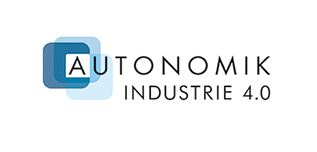Cross-cutting topics
- Business models for Industry 4.0
- IT-Security for Industry 4.0
- Ju-RAMI 4.0
- Legal challenges
- Standardisation
- The future of work in Industry 4.0
IT-Security for Industry 4.0
For a long time, production plant security was interpreted as operating safety , i.e. uninterrupted operation of the plant without any risk of injury. With the use of computer-based and, at times, networked machines in production, a new security requirement arose, i.e. information security. With the cyber-physical systems in Industry 4.0, the degree of networking and the "intelligence" of the components continue to rise: Workpieces, machines and conveyor systems are now components of an IT network which permanently communicate with each other and with external parties. The workpiece makes its own way to the machine which reports to it that it has free processing capacity; through self-diagnosis, the milling machine detects that its cutting tool is worn and informs the production technician who finds out about the status of the machine through remote access and can then plan tool replacement. Just like any other ICT network, this production network can also be attacked, spied on and disrupted. Under certain circumstances, this could pose a risk for life and limb and result in high costs due to production downtimes or the loss of confidential information.
Technologies, methods and standards for protecting information security are well-known from the world of information and communication technology. Despite this, there are still considerable challenges facing communications with new cyber-physical systems in production.
When it comes to classical operating safety, there are already established methods for assessing risks as well as quantitative testing and certification methods. In contrast to this, it is assumed in information security that an attacker will proceed in a targeted manner and adapt his approach to overcome the existing protection measures. Attacks will also become easier as technology progresses: In the future, powerful computers will be able to break key lengths that are today considered to be secure. That's why there is no permanent degree of information security that can be technically achieved once and for all and then certified. Instead, it is possible to demand the existence of certain security management systems and the use of technologies that are considered to be sufficiently secure. Despite this, a breach of information security can also threaten operating safety, for instance, if emergency equipment is switched off. Both security and safety are becoming increasingly interlocked even though there are still no practical approaches that allow both aspects to be jointly considered in technical guidelines and accreditation.
The timely availability of information, for instance, for machine control, often plays a much more important role in production than in other IT networks where short delays can be accepted. The security technologies must take into account this specific priority of the protection goals in production and must be adapted if necessary. Installing updates of security software (patches) at short notice, for instance, is not possible if this disrupts production workflows.
Under some circumstances, the production network can include a large number of partners, suppliers, customers, logistics firms and other service providers. This means that customary procedures for setting up and operating security management systems, which up to now were primarily geared to implementation in a given organisation, must be expanded accordingly. Even the maintenance technician from an external company who accesses a CNC machine remotely or on site using a laptop, or the IT infrastructure of a small supplier company must be adapted to meet the needs of security management.
In the producing sector, there are many questions that have yet to answered regarding the security of networked and ever-smarter machines and systems in this sector. One of the key topics of scientific assistance for "AUTONOMICS for Industry 4.0" is hence information security when autonomous cyber-physical systems are used in production. The central issues here are:
Which of the known security methods and technologies make sense and are suitable for this kind of application, and how, when necessary, can they be adapted and upgraded?
How can the relationship between information security and operating safety be properly defined and warranted?
- Recommend this page:
- Print view
